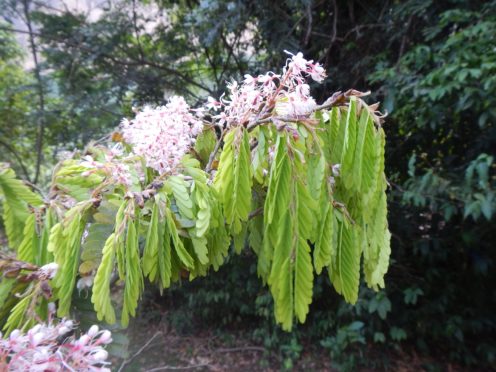A new bug-eating pitcher plant, an edible “hedgehog” mushroom and a weird species living in a waterfall are among the new plants and fungi found this year.
The Royal Botanic Gardens, Kew, is highlighting some of its top discoveries for 2018, from among the scores of species of plants and fungi found in places ranging from the mountainsides of the Andes to Asian black markets.

Kew and its partners have found some 128 vascular plants and 44 species of fungi around the world this year, many of which are already under threat of extinction just as they have been recorded for the first time.
The plant experts have selected some of their highlights, including a “showy” orchid first found on the black market in Laos, a new wild relative of the commercial Allspice tree and two types of morning glories from Bolivia.
The biggest new discovery is an 80ft (24m) tree from Guinea, which is endangered by the clearance of tiny remnants of rainforest among the hills of the coastal plain where it dominates the canopy.

And a new genus of plant with bizarre, large, pillar-like structures which was found in a waterfall in Sierra Leone has been immediately classified as critically endangered because it faces threats from mining and and a hydroelectric project.
A second discovery of the genus in Guinea is also threatened by a hydroelectric project, which means it could be extinct within the next two years.
Scientists are planning to travel to Guinea in early 2019 to search for the plant in the wild so seeds can be collected to store for conservation elsewhere in the world.

Some of the new species discovered this year could have uses for humans, including “hedgehog” mushrooms – named because the spores are not carried on gills but spikes or “teeth” – many of which are thought to be edible.
A new species of purple-flowering yam from South Africa could have medicinal uses, while the pollen of an attractive white flower from Guinea has been found to contain more than 40 chemicals classified as “triterpenoids”, known for their medicinal value, with potential anti-cancer properties.
Kew botanist Dr Martin Cheek said: “It seems unbelievable that we scientists are still discovering species of plants and fungi new to science out in the wild – often in the most unlikely of places.
“For example, this year we found a large tree by an international highway in Africa, and a spectacular slipper orchid was found being sold off the back of a barrow in a major Asian city.
“Many of these new species have potential benefits for humanity, from beautiful pot plants to new medicines or crops, but sadly we are finding that most of these new species are threatened with extinction due to habitat destruction, or are even likely extinct already.”
